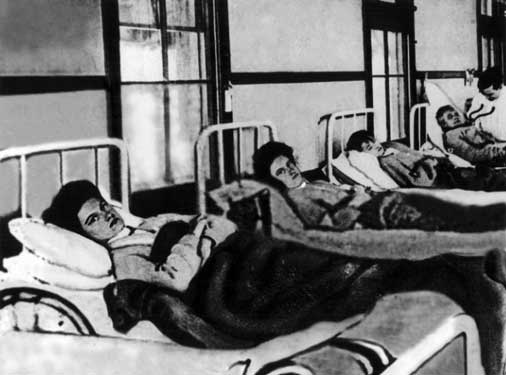Summer of 1906 brought about an unexpected arrival into the Warren’s rented summer household when “… one of the Warren’s daughters became ill. Next, two maids and Mrs. Warren were affected followed by another daughter and the gardener.”1 While summer vacationing in a wealthy neighborhood of Oyster Bay, Long Island, six members in a household became gravely ill with typhoid fever. Prior to this infection case, many people associated typhoid fever infections were usually from the lower class because typhoid was known to be caused by poor sanitation of water and food. The Thompsons, who rented their house to the Warren family, hired George Soper to investigate the cause of the typhoid fever outbreak in the household. They were afraid their house would never be rented again because it was contaminated with the bacteria causing typhoid fever. Soper was a distinguished scholar who had attained his Ph.D in the field of Sanitary Engineer. His previous work with the typhoid epidemic made him vital as an epidemiologist working for the Department of Health.2

Soper began by thoroughly and systematically investigating all the known facts that had been presented to him, and one by one he ruled out all types of potential sources of infection. Finally, he found that the family had changed cooks prior to the family’s typhoid fever attack.3 Due to Soper’s previous medical investigations, he was well aware that a person can be a healthy carrier of certain diseases, and typhoid was one of them. This means that a person could be infected by some type of a pathogen and they would not demonstrate any symptoms. Due to this, the person would seem healthy and not a menace to society. While the person may seem healthy, they can become the driving force that helps spreads the pathogen. This phenomenon occurs in about 3% of patients who recover from the bacterial infection that causes typhoid fever.4
Bacteria have evolved alongside humans in order to successfully infect themselves into a human host. Pathogens continue to spread into the human population, which can be seen in the case of Salmonella typhi that infected Mary Mallon, the family’s cook. Though she was never gravely ill from her infection, the pathogen had embedded itself within her body and it used her as a vessel to bring the infection to many unsuspecting people. Due to the number of people she infected, she became known as Typhoid Mary as she unknowingly infected fifty-one people with her cooking, which ultimately led to the deaths of three people.5
Mary Mallon, an Irish immigrant, became the first known asymptomatic carrier of typhoid fever. Her work as a cook placed everyone who ate her food at great risk of getting typhoid fever.6 A bacterial infection that causes typhoid fever to occur can be passed via fecal matter or contaminated water used to cook food. Once this type of bacteria enters the human body, it primarily lives in the stomach until it progresses into the lymphatic system and finally, makes its way to the bloodstream, where it is spread throughout the rest of the body.7 Mallon posed a great risk to societal health, but more specifically to those she cooked for, especially when she made her famous and well-loved desert peach ice cream. High heat kills the typhoid causing bacteria; however, in cold foods the bacteria is placed in a frozen state. Once in the human body, it metastasizes and eventually enters the bloodstream and there it facilitates its spread throughout the body.

Antibiotics that could treat bacterial infections such as typhoid fever were not introduced to the until the early 1940s. Therefore, during the late 1870s, only the symptoms caused by the infection such as fever, fatigue, joint pain, headache, constipation, and a rash consisting of a rosy pink color spotted across the abdomen could be treated by physicians until the body completely fought off the bacterial infection on its own.8
After Soper tracked down Mallon, who had been employed as a cook for another wealthy family after leaving the Warrens, he asked her for a sample of her fecal matter, as asymptomatic carriers have the bacteria in their stool. He needed the sample in order to properly investigate for the typhoid-causing bacteria so he could soundly confirm that she was the source that infected the Warren’s family. Unfortunately, Mallon refused and chased Soper out of the house, stating that it was impossible for her to be the source. She had never contracted the disease and she had been completely healthy throughout her stay with the Warrens. Even while treating the sick, she never became ill herself.9 Soper’s accusations were not well received because Mallon heavily relied on her cooking skills as her source of income. Furthermore, if she were infecting people with the bacteria known for causing typhoid fever, then she would never be hired as a cook again. Mallon did not know that she was carrying the disease, and more importantly, she did not know that through her cooking she could spread the bacteria, so she could not believe she was infecting anyone through her cooking.
With the help of New York City Department of Health, Soper was able to track down Mallon once again and have her removed from society as she continued to infect the families for whom she cooked. After her removal, she was placed on North Brother Island, an island where many other patients infected with deadly diseases lived because they posed serious health risks for the larger public. Her only crime was being a carrier of typhoid and for this she was sentenced to live on an island. Alongside many other people who carried grave and highly infectious diseases that Mallon was not immune to, she was being placed in an environment that left her vulnerable, free today and held captive on an island the next day. Her freedom was stripped away from her as she was forced to live away from her family, friends, and anyone she knew. While living on this island, Mallon received the help of other doctors who argued not only had the Department of Health grossly abused their power by removing Mallon from society, but they deprived her of her right to happiness, and she planned to sue. Many doctors also argued that if Mallon trained to do another type of job that was not food related, then she would not be able to infect people. The bacteria posed no health threats once outside the host body.10 Mallon challenged America’s Public health system and won. After three years of living in isolation, Mallon was free to go, on one condition: that she may never become a cook again. With the help of the judge who was on her case, she became employed as a laundress; however, this job proved not be as lucrative as her cooking job.
The Department of Health realized that of those who had survive typhoid fever, 3% of them would became asymptomatic carriers of the pathogen. As the number of survivor grew so did the number of asymptomatic carriers. The New York City’s Health Department knew that they had to specially retrain all food handler who had became asymptomatic carriers of typhoid fever. The city also employed other ways of minimizing infection such as paying typhoid fever carriers not to go to work, in efforts to minimize potential typhoid outbreak case.
The city of New York was doing very well until a typhoid fever broke out in a hospital, and twenty-five people become infected with typhoid and two of them died. The source of the bacteria was unknown. When further investigation was conducted by Soper, he found out that some of the other kitchen workers nicknamed the newly hired cook as Typhoid Mary. It was not long until Mallon was found, and in 1915 she was apprehended by Public Health officials. Without a fight she cooperated with the Health department and went to live on the island she had successfully and legally left, only to return four years later.11 The moment she broke the only agreement with the judge was the moment that sealed her fate. She was allowed to leave the island periodically to visit family, shop, and integrate herself into society away from the island, while being supervised.

The name Mary Mallon might be lost in the pages of history, but the infamous Typhoid Mary will continue to live on as the first known carrier of typhoid. Throughout her debacle she fought for her human rights and was unafraid to challenge the Health Department’s approach to people who were asymptomatic carriers of typhoid fever. Her story will forever be a potent symbol of America’s fear of diseases.
- Judith Walzer Leavitt, Typhoid Mary (Beacon Press, 1996), 15. ↵
- Judith Walzer Leavitt, Typhoid Mary (Beacon Press, 1996), 15. ↵
- Judith Walzer Leavitt, Typhoid Mary (Beacon Press, 1996), 16. ↵
- Encyclopedia of Medicine, 2016, s.v. “Typhoid Fever.” ↵
- Encyclopedia Britannica, November 15, 2017, s.v.”Typhoid Mary.” ↵
- Jennifer Ashley Wright, Get well soon: History’s Worst Plagues and the Heroes Who Fought Them (New York : Henry Holt and Company, 2017), 77-79. ↵
- Encyclopedia of Medicine, 2016, s.v. “Typhoid Fever.” ↵
- New World Encyclopedia, 2017, “Typhoid Fever.” ↵
- Judith Walzer Leavitt, Typhoid Mary (Beacon Press, 1996), 15. ↵
- Encyclopedia of Medicine, 2016, s.v. “Typhoid Fever.” ↵
- NPR.org, October 30, 2014, Awful Moments In Quarantine History: Remember Typhoid Mary? ↵



79 comments
Lesley Martinez
I did not know about Typhoid Mary. It’s interesting to read that typhoid fever was known to be caused by poor sanitation of water and food. Along with the fact that the Thompsons were able to hire a Sanitary Engineer to investigate the cause. I’m surprised that Mary Mallon was infected by Salmonella typhi yet was never seriously ill herself. North Brother Island sounds like a frightening place to go to, so I’m surprised that Mary would risk cooking again and end up back at the island. Very interesting article!
Michael Thompson
While I feel bad for Mary Mallon, I also feel upset that she knowingly went back to a position, against the judges orders, that would kill people without care. I understand that the cooking job would pay more, but she was literally killing people, and making dozens sick. After the second time, I think she kind of deserved, or maybe needed is a better word, to be isolated from everyone else, that way she wouldn’t be a danger to society. If she took precautions not to be a danger, than that would be a different story. But she didn’t so the end makes sense.
Juan Arceo
I did not expect this article to be the way that it was due to the title but I am still glad that I read it. I know a thing or two about cooking since I was a part of the culinary pathway at my high school and I was also fortunate to be the only person in my high school to have actually passed both the ServSafe Food Handlers and Food Managers. This article reminded me of when I had to learn to cook food to the desired temperature to get rid of pathogens and how to prevent certain outbreaks like typhoid fever from spreading to the customer or in this case, the people that she worked for in their house. Overall, good article!
Mauro Bustamante
Reading this article I acknowledge the struggle and hurt that Mary Mallon had went through being felt like a prisoner and treated so unequally at her work place. However it doesn’t take away the fact that she effected so many innocent co-workers that probably felt the same way she did. Mary Mallon did know she was a carrier of the disease because if she did not know she was infected, she would have agreed to get tested because she would’ve been worried about the health of the people she worked for. Even though she was treated unequally and like a prisoner, she still shouldn’t have done what she did. This article was interesting and well written and very informative.
Rosa Robledo Martinez
Overall one of the best written articles! I never heard about this tragic event nor Mary Mallon before reading but I am glad that I am informed about it now. I believe that Mary shouldn’t have been treated as if she was locked up in a jail cell, but I do think that she should suffer some consequences. I think she knew that she had a disease that kept spreading to others and still kept cooking. If she would have stopped cooking for others maybe she wouldn’t experience a horrible consequence.
Celeste Flores
The fact that someone was sent away to an island and stripped of her rights just because the Health System did not find another way to treat a disease is crazy to me. Mary Mallon was a victim of the malfunction of the system, just like a lot of people during the past. I understand that she should not have gone back to cooking because she knew she could infect more people. As a matter of public health, the department of public health should have handled it better than totally isolating victims.
Madelynn Salinas
This article was unbelievably interesting to read! I do empathize with Mary Mallon and the consequences she suffered, but at the same time she suspiciously effected so many innocent people and denied to get tested which comes off as very guilty so although I think prison was the right call, I do believe she needed to suffer some type of consequence. Working in the line of service and interacting with some many as a career, is something she should’ve sacrificed for the greater good.
Kasandra Ramirez Ferrer
I think what Mary Mallon didn’t deserve to be treated as a prisoner but I believe Mallon knew she was a carrier of the disease because if she did not know she was infected, she would have agreed to get tested because she would’ve been worried about the health of the people she worked for. I also think she wasn’t a good person because she refused to do the analysis and keep working risking people to get infected. If Mallon had agreed to be tested, she maybe would’ve been able to keep it private and her career would have been fine but she caused her own faith.
Brianna Ramos
I had never heard about this event or Mary Mallon before reading this article. It was interesting to read about the spread of typhoid and the public’s “remedy” for Mary and the safety of others (quarantined on an island). Overall, the ruling of the Department of Health was appropriate they should not be allowed to isolate those with disease to an island to contain spreading. However, I do understand why she was sent back after she attempted to be a cook again, she was being negligent even after she was informed. It does go to show how far we have come when it comes to epidemics and our plans for containment today.
Amanda Uribe
I wonder what it was like to be Mary Mallon. I guess it will always be a mystery as to how she was the first to carry Typhoid. If I was Mary I would be angry that I was taken away from my own family and friends because of something that I’d never even heard about. I understand why people were scared of her. But she did not deserve to be treated like a prisoner.